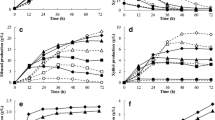Abstract
Different initial cell concentrations of a recombinant flocculent Saccharomyces cerevisiae MA-R4 were evaluated for their effects on xylose fermentation and glucose–xylose cofermentation. A high initial cell concentration greatly increased both the substrate utilization and ethanol production rates. During xylose fermentation, the highest rates of xylose consumption (2.58 g/L h) and ethanol production (0.83 g/L h) were obtained at an initial cell concentration of 13.1 g/L. During cofermentation, the highest rates of glucose consumption (14.4 g/L h), xylose consumption (2.79 g/L h), and ethanol production (6.68 g/L h) were obtained at an initial cell concentration of 12.7 g/L. However, a high initial cell density had no positive effect on the maximum ethanol concentration and ethanol yield mainly due to the increased amount of by-products including xylitol. The ethanol yield remained almost constant (0.34 g/g) throughout xylose fermentation (initial cell concentration range, 1.81–13.1 g/L), while it was slightly lower at high initial cell concentrations (9.87 and 12.7 g/L) during cofermentation. The determination of the appropriate initial cell concentration is necessary for the improvement of substrate utilization and ethanol yield.




Similar content being viewed by others
References
Saha, B. C. (2003). Journal of Industrial Microbiology & Biotechnology, 30, 279–291.
Hahn-Hägerdal, B., Karhumaa, K., Fonseca, C., Spencer-Martins, I., & Gorwa-Grauslund, M. F. (2007). Applied Microbiology and Biotechnology, 74, 937–953.
Jeffries, T. W., & Jin, Y. S. (2004). Applied Microbiology and Biotechnology, 63, 495–509.
Hahn-Hägerdal, B., Karhumaa, K., Jeppsson, M., & Gorwa-Grauslund, M. F. (2007). Advances in Biochemical Engineering/Biotechnology, 108, 147–177.
van Maris, A. J., Winkler, A. A., Kuyper, M., de Laat, W. T., van Dijken, J. P., & Pronk, J. T. (2007). Advances in Biochemical Engineering/Biotechnology, 108, 179–204.
Matsushika, A., Inoue, H., Kodaki, T., & Sawayama, S. (2009). Applied Microbiology and Biotechnology, 84, 37–53.
Van Vleet, J. H., & Jeffries, T. W. (2009). Current Opinion in Biotechnology, 20, 300–306.
Matsushika, A., Inoue, H., Murakami, K., Takimura, O., & Sawayama, S. (2009). Bioresource Technology, 100, 2392–2398.
Matsushika, A., Inoue, H., Watanabe, S., Kodaki, T., Makino, K., & Sawayama, S. (2009). Applied and Environmental Microbiology, 75, 3818–3822.
van Hoek, P., de Hulster, E., van Dijken, J. P., & Pronk, J. T. (2000). Biotechnology and Bioengineering, 68, 517–523.
Cheng, J. S., Ding, M. Z., Tian, H. C., & Yuan, Y. J. (2009). Proteomics, 9, 1–10.
Sen, R., & Swaminathan, T. (2004). Biochemical Engeering Journal, 21, 141–148.
Krishnan, M. S., Ho, N. W. Y., & Tsao, G. T. (1999). Applied Biochemistry and Biotechnology, 77–79, 373–388.
Agbogbo, F. K., Coward-Kelly, G., Torry-Smith, M., Wenger, K., & Jeffries, T. W. (2007). Applied Biochemistry and Biotechnology, 136–140, 653–662.
Zhong, C., Lau, M. W., Balan, V., Dale, B. E., & Yuan, Y. J. (2009). Applied Microbiology and Biotechnology, 84, 667–676.
Kuriyama, H., Seiko, Y., Murakami, T., Kobayashi, H., & Sonoda, Y. (1985). Journal of Fermentation Technology, 63, 159–165.
Matsushika, A., Watanabe, S., Kodaki, T., Makino, K., Inoue, H., Murakami, K., et al. (2008). Applied Microbiology and Biotechnology, 81, 243–255.
Acknowledgments
The authors thank Dr. Ohgiya Satoru (AIST) for his useful discussions and Ms. Maiko Kato for her technical assistance. This study was supported by the New Energy and Industrial Technology Development Organization (NEDO), Japan.
Author information
Authors and Affiliations
Corresponding author
Rights and permissions
About this article
Cite this article
Matsushika, A., Sawayama, S. Effect of Initial Cell Concentration on Ethanol Production by Flocculent Saccharomyces cerevisiae with Xylose-Fermenting Ability. Appl Biochem Biotechnol 162, 1952–1960 (2010). https://doi.org/10.1007/s12010-010-8972-6
Received:
Accepted:
Published:
Issue Date:
DOI: https://doi.org/10.1007/s12010-010-8972-6




